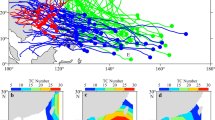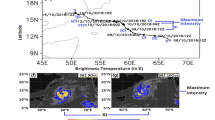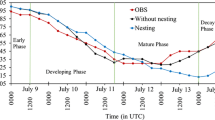Abstract
Sea surface temperature (SST) cooling is a typical ocean response to tropical cyclones (TCs). Previous studies have shown that TC-induced SST cooling is influenced by the TC characteristics, ocean stratification, and background vorticity. However, whether internal tides (ITs) affect TC-induced SST cooling remains unclear. Based on a series of numerical simulations in the South China Sea, the influence of ITs on TC-induced SST cooling is explored in this study. Results indicate that ITs can enhance TC-induced SST cooling by 0.2 − 0.4 °C in the Luzon Strait. Temperature budget analysis shows that ITs modulate the SST cooling mainly through changing the vertical mixing and advection. In the Luzon Strait, ITs enhance the vertical mixing but suppress the vertical advection. Because the contribution of vertical mixing to SST cooling is one order of magnitude higher than that of vertical advection, ITs enhance TC-induced SST cooling in the Luzon Strait mainly through enhancing the vertical mixing. Moreover, the enhancements of vertical mixing and SST cooling induced by ITs are found to be related to the TC characteristics. One reason is that in addition to ITs, the high-frequency waves generated by the interaction between TC-induced near-inertial waves and ITs also contribute to the shear and hence the turbulent mixing.











Similar content being viewed by others

Data availability
The CROCO code, barotropic tidal forcing data, and WOA09 data are available at www.croco-ocean.org. The ETOPO1 bathymetry data are available at www.ncei.noaa.gov/access/metadata/landing-age/bin/iso?id=gov.noaa.ngdc.mgg.dem: 316. The Tropical Cyclone best track data are available at http://tcdata.typhoon.org.cn. The simulated results in this study are available from the corresponding author upon reasonable request.
References
Alford M, MacKinnon J, Nash J, Simmons H, Pickering A, Klymak J et al (2011) Energy flux and dissipation in Luzon Strait: two tales of two ridges. J Phys Oceanogr 41:2211–2222. https://doi.org/10.1175/JPO-D-11-073.1
Alford M, Peacock T, Mackinnon J, Nash J, Buijsman M, Centuroni L et al (2015) The formation and fate of internal waves in the South China Sea. Nature 521:65–69. https://doi.org/10.1038/nature14399
Cao A, Guo Z, Song J, Lv X, He H, Fan W (2018) Near-inertial waves and their underlying mechanisms based on the South China Sea internal wave experiment (2010–2011). J Geophys Res: Oceans 123(7):5026–5040. https://doi.org/10.1029/2018JC013753
Cao A, Guo Z, Wang S, Chen X, Lv X, Song J (2019) Upper ocean shear in the northern South China Sea. J Oceanogr 75:525–539. https://doi.org/10.1007/s10872-019-00520-x
Cao A, Guo Z, Wang S, Guo X, Song J (2022) Incoherence of the M2 and K1 internal tides radiated from the Luzon Strait under the influence of looping and leaping Kuroshio. Prog Oceanogr 206:102850. https://doi.org/10.1016/j.pocean.2022.102850
Chan J (2005) Interannual and interdecadal variations of tropical cyclone activity over the Western North Pacific. Meteorol Atmos Phys 89:143–152. https://doi.org/10.1007/s00703-005-0126-y
Chiang T, Wu C, Oey L (2011) Typhoon Kai-Tak: an ocean’s perfect storm. J Phys Oceanogr 41:221–233. https://doi.org/10.1175/2010JPO4518.1
Cione JJ, Uhlhorn EW (2003) Sea surface temperature variability in hurricanes: implications with respect to intensity change. Mon Weather Rev 131(8):1783–1796. https://doi.org/10.1175//2562.1
Dare R, Mcbride J (2011) Sea surface temperature response to tropical cyclones. Mon Weather Rev 139:3798–3808. https://doi.org/10.1175/MWR-D-10-05019.1
D’Asaro E, Black P, Centurioni L, Harr P, Jayne S, Lin I et al (2011) Typhoon-ocean interaction in the Western North Pacific: part 1. Oceanography 24:24–31. https://doi.org/10.5670/oceanog.2011.91
Emanuel K (2003) Tropical cyclones. Annu Rev Earth Pl Sc 31:75–104. https://doi.org/10.1146/annurev.earth.31.100901.141259
Greatbatch RJ (1984) On the response of the ocean to a moving storm: parameters and scales. J Phys Oceanogr 14:59–78. https://doi.org/10.1175/1520-0485(1984)014<0059:OTROTO>2.0.CO;2
Guan S, Zhao W, Huthnance J, Tian J, Wang J (2014) Observed upper ocean response to typhoon Megi (2010) in the Northern South China Sea. J Geophys Res: Oceans 119(5):3134–3157. https://doi.org/10.1002/2013JC009661
Guan S, Zhao W, Sun L, Zhou C, Liu Z, Hong X et al (2021) Tropical cyclone-induced sea surface cooling over the Yellow Sea and Bohai Sea in the 2019 Pacific typhoon season. J Marine Syst 217:103509. https://doi.org/10.1016/j.jmarsys.2021.103509
Guo Z, Cao A, Lv X, Song J (2020) Impact of multiple tidal forcing on the simulation of the M2 internal tides in the northern South China Sea. Ocean Dynam 70(2):187–198. https://doi.org/10.1007/s10236-019-01324-9
Jacob SD, Shay LK, Mariano AJ, Black PG (2000) The 3D oceanic mixed layer response to Hurricane Gilbert. J Phys Oceanogr 30:1407–1429. https://doi.org/10.1175/1520-0485(2000)030%3c1407:TOMLRT%3e2.0.CO;2
Jaimes B, Shay LK (2010) Near-inertial wave wake of hurricanes Katrina and Rita over mesoscale oceanic eddies. J Phys Oceanogr 40:1320–1337. https://doi.org/10.1175/2010JPO4309.1
Jelesnianski CP (1965) A numerical calculation of storm tides induced by a tropical storm impinging on a continental shelf. Mon Weather Rev 93(6):343–358. https://doi.org/10.1175/1520-0493(1993)093%3c0343:ANCOS%3e2.3.CO;2
Jullien S, Menkes C, Marchesiello P, Jourdain N, Lengaigne M, Koch-Larrouy A et al (2012) Impact of tropical cyclones on the heat budget of the South Pacific Ocean. J Phys Oceanogr 42:1882–1906. https://doi.org/10.1175/JPO-D-11-0133.1
Large WG, McWilliams JC, Doney SC (1994) Oceanic vertical mixing: a review and a model with a nonlocal boundary layer parameterization. Rev Geophys 32(4):363–403. https://doi.org/10.1029/94RG01872
Lin I, Wu C, Pun I, Ko D (2008) Upper-ocean thermal structure and the Western North Pacific category 5 typhoons. Part I: Ocean Features and the Category 5 Typhoons’ Intensification. Mon Weather Rev 136(9):3288–3306. https://doi.org/10.1175/2008MWR2277.1
Lin I, Pun IF, Wu C (2009) Upper-ocean thermal structure and the Western North Pacific Category 5 typhoons. Part II: Dependence on Translation Speed. Mon Weather Rev 137:3744–3757. https://doi.org/10.1175/2009MWR2713.1
Marchesiello P, Nguyen NM, Gratiot N, Loisel H, Anthony EJ, Dinh CS et al (2019) Erosion of the coastal Mekong delta: assessing natural against man induced processes. Cont Shelf Res 181:72–89. https://doi.org/10.1016/j.csr.2019.05.004
Niwa Y, Hibiya T (2004) Three-dimensional numerical simulation of M2 internal tides in the East China Sea. J Geophys Res: Oceans 109(C4) https://doi.org/10.1029/2003JC001923
Pei Y, Zhang R, Chen D (2015) Upper ocean response to tropical cyclone wind forcing: a case study of typhoon Rammasun (2008). Sci China Earth Sci 58(9):1623–1632. https://doi.org/10.1007/s11430-015-5127-1
Price JF (1981) Upper ocean response to a hurricane. J Phys Oceanogr 11(2):153–175. https://doi.org/10.1175/1520-0485(1981)011%3c0153:UORTAH%3e2.0.CO;2
Pun I-F, Lin I-I, Lien C-C, Wu C-C (2018) Influence of the size of supertyphoon Megi (2010) on SST cooling. Mon Weather Rev 146:661–677. https://doi.org/10.1175/MWR-D-17-0044.1
Qiao M, Cao A, Song J, Pan Y, He H (2022) Enhanced turbulent mixing in the upper ocean induced by super Typhoon Goni (2015). Remote Sens-Basel 14:2300. https://doi.org/10.3390/rs14102300
Renault L, Mcwilliams J, Penven P (2017) Modulation of the Agulhas current retroflection and leakage by oceanic current interaction with the atmosphere in coupled simulations. J Phys Oceanogr 47:2077–2100. https://doi.org/10.1175/JPO-D-16-0168.1
Shay LK, Black PG, Mariano AJ, Hawkins JD, Elsberry RL (1992) Upper ocean response to Hurricane Gilbert. J Geophys Res: Oceans 97(C12):20227–20248. https://doi.org/10.1029/92JC01586
Sprintall J, Tomczak M (1992) Evidence of the barrier layer in the surface layer of the tropics. J Geophys Res: Oceans 97(C5):7305–7316. https://doi.org/10.1029/92JC00407
Sun Z, Hu J, Zheng Q, Gan J (2015) Comparison of typhoon-induced near-inertial oscillations in shear flow in the northern South China Sea. Acta Oceanol Sin 34:38–45. https://doi.org/10.1007/s13131-015-0746-0
Tian J, Yang Q, Zhao W (2009) Enhanced diapycnal mixing in the South China Sea. J Phys Oceanogr 39(12):3191–3203. https://doi.org/10.1175/2009JPO3899.1
Xu Z, Liu K, Yin B, Zhao Z, Wang Y, Li Q (2016) Long-range propagation and associated variability of internal tides in the South China Sea. J Geophys Res: Oceans 121(11):8268–8286. https://doi.org/10.1002/2016JC012105
Yang B, Hou Y, Hu P, Liu Z, Liu Y (2015) Shallow ocean response to tropical cyclones observed on the continental shelf of the northwestern South China Sea. J Geophys Res: Oceans 120(5):3817–3836. https://doi.org/10.1002/2015JC010783
Yang Q, Zhao W, Liang X, Tian J (2016) Three-dimensional distribution of turbulent mixing in the South China Sea. J Phys Oceanogr 46:769–788. https://doi.org/10.1175/JPO-D-14-0220.1
Ying M, Zhang W, Yu H, Lu X, Feng J, Fan Y et al (2014) An overview of the China meteorological administration tropical cyclone database. J Atmos Ocean Tech 31(2):287–301. https://doi.org/10.1175/JTECH-D-12-00119.1
Zhang Y, Liu Y, Guan S, Wang Q, Zhao W, Tian J (2022) Sudden track turning of Typhoon Prapiroon (2012) Enhanced the upper ocean response. Remote Sens-Basel 15:302. https://doi.org/10.3390/rs15020302
Zhao Z (2014) Internal tide radiation from the Luzon Strait. J Geophys Res: Oceans 119(8):5434–5448. https://doi.org/10.1002/2014JC010014
Zhu T, Zhang D (2006) The impact of the storm-induced SST cooling on hurricane intensity. Adv Atmos Sci 23:14–22. https://doi.org/10.1007/s00376-006-0002-9
Funding
This study is supported by the National Natural Science Foundation of China (Grant number: 42176002) and the open fund of the State Key Laboratory of Satellite Ocean Environment Dynamics, Second Institute of Oceanography, Ministry of Natural Resources (Grant number: QNHX2218).
Author information
Authors and Affiliations
Corresponding author
Ethics declarations
Conflict of interest
The authors declare no competing interests.
Appendix. Sensitivities of simulated SST cooling to horizontal model resolution and vertical sigma layers
Appendix. Sensitivities of simulated SST cooling to horizontal model resolution and vertical sigma layers
To explore the influences of horizontal model resolution and the number of vertical sigma layers on the SST cooling in CROCO, sensitivity experiments are carried out based on Exp2. Detailed settings of these sensitivity experiments are listed in Table 2
Figure 12 shows the spatial distribution of SST cooling in these sensitivity experiments, and Fig. 13 shows the SST cooling averaged in the Luzon Strait (dashed box in Fig. 12). Results indicate that the horizontal model resolution influences the simulated SST cooling, i.e., lower horizontal resolution (e.g. 1/5° and 1/10°) leads to smaller SST cooling. When the horizontal resolution is sufficiently finer (e.g., 1/15° and 1/20°), the simulated SST cooling tends to be stable. In contrast, the number of vertical sigma layers has little effect on the simulated SST cooling. Based on these results, we use 1/20° horizontal resolution and 35 vertical sigma layers in the simulations of this study.
Rights and permissions
Springer Nature or its licensor (e.g. a society or other partner) holds exclusive rights to this article under a publishing agreement with the author(s) or other rightsholder(s); author self-archiving of the accepted manuscript version of this article is solely governed by the terms of such publishing agreement and applicable law.
About this article
Cite this article
Cheng, S., Cao, A., He, H. et al. Numerical study on the influence of internal tides on tropical-cyclone-induced sea surface temperature cooling in the South China Sea. Ocean Dynamics 73, 449–461 (2023). https://doi.org/10.1007/s10236-023-01561-z
Received:
Accepted:
Published:
Issue Date:
DOI: https://doi.org/10.1007/s10236-023-01561-z





